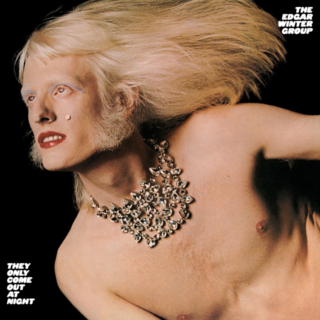
Edgar Winter’s White Trash came slinking out of the shadows in 1971. Two years later, he rode this cold slab of rock and roll albinism to the top. The Album and the Albino, the high priest’s Alb and Albumen, the lowly white of an egg. They’re all linked, each of them descending from “Albus,” the Latin word for absolute whiteness. Albedo is a bit more complicated. For the astronomer, it’s the reflecting power of a planet or moon. For the physicist, it’s the degree to which a surface reflects back cosmic radiation.
You want more? You need more? We’ve got it - all of the evidence hidden right out in the open. Album covers are magic amulets, containers of pop cult esoterica, squares of throwaway idiocy and at the same time secret maps of the starry regions. They Only Come Out At Night - how much more obvious does it need to be?
The cover features a Francesco Scavullo fashion photo of the whitest rock star on the planet. Naked, Winter poses at a strange oblique angle, as though he’s an astral messenger zooming through space/time. But of course he’s no angel, nor a devil. Winter, here, emerges as a true celestial emanation, neither male nor female, alien nor human, but the next species. His eyes gleam upward - toward the heavens? in drugged ecstasy? dreaming of himself as the next shooting star? Scavullo makes Winter look like a living comet - complete with tail of icy colorless hair streaming behind. A golden beauty mark pulses on his cheek. His lips are painted a vivid red. The only thing covering his naked skin is a multi-tiered diamond necklace. Here is, in short, maximum space-freak: milk-pale skin, midnight black background, and a slash of juicy crimson on his lips.
On the back cover he’s even more transgressively genderless, one half pink satin Barbie and one half Prince Charming. The other members of the band are nowhere near as fetchingly weird, mustering about as much menace as sebaceous sophomores dressed up for the prom. And for the most part, the music they create is banal white-boy schlock, party tunes such as “Hanging Around” and “We All Had a Real Good Time,” and that pinnacle of originality, “Rock ‘n’ Roll Boogie Woogie Blues.”
Then there’s “Frankenstein,” the monster hit off the album, the only cut that matters. Supposedly the track got its name because it was cobbled together out of various unrelated parts. We'll never know if this is true - the scars and seams and stitch-marks aren’t obvious. To these ears, it’s not a hodgepodge of mismatched limbs and organs, but the zap-spark sound of the mad scientist’s lab. Winter’s synthesizer dominates the mix, though there’s less bleeping here and far more squiggle-riff voltaic surges than on other synth-heavy tunes of the time.
In a way, it’s just another blues instrumental, complete with drum solo and sax break. But updated and juiced with the high tech of the day, it’s the aural equivalent of the comet Winter portrays on the cover. At one point he even gives us a perfect buzzy musical sketch of a space craft landing on the moon. Glimmer, glam, glitz - all of these of course are about reflection, not absorption, of light. And this Frankenstein shines like a disintegrating egg of trans-solar ice as it swings around the sun.
Though the entire platform shoe craze of the time can be traced back to Boris Karloff’s huge clunky Frankenstein footwear, there’s little else of him present in this track. No hints of the Thorazine shuffle, neck-bolts, growls or murderous leer. This is the monster as portent, not brainless killer hulk.
Ultimately, the Albedo of this Album, the reflection of cosmic radiation, is about Edgar Winter’s skin, not the movie monster’s. Karloff’s had a greenish cast, as least in the later incarnations. Winter’s is the pure snowy white of the albino. But they are still both monsters in the oldest sense of the word. Before it was the shambling hell-creature of horror stories, The Monster was a baleful warning or sign. In Latin, the word was “monstrum,” meaning a divine portent of misfortune. This term ultimately comes from “monstrare” - which indicates a showing or unveiling. In short, the monster is a revelation. And certainly this tune gives us a glimpse of the soul-light that only comes out of its secret place at night. This is album-as-altar and pop musician as sacrificial priest. This is the white monster as portent, omen and warning.
0 comments:
Post a Comment